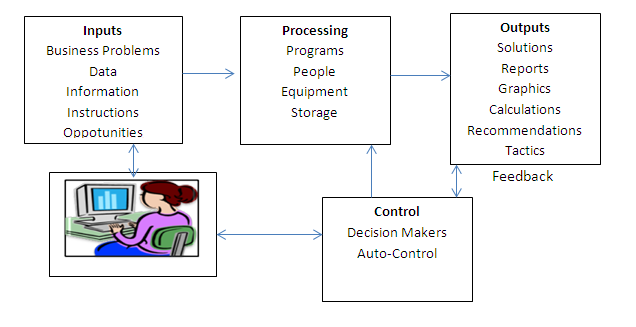
Information System: Definition and Examples
An information system (IS) collect, process, stores, analyzes, and disseminates information for a specific purpose. Like any others system, an information system includes inputs ( data, instructions ) and outputs ( reposts, calculation ). It processes the inputs by using technology such as PCs and produces outputs that are sent to users or to other systems via electronic networks. A feedback mechanism that controls the operation may be included ( see Figure 1.4 ). Like any other system, an information system also includes people, procedures, any physical facilities, and it operates within an environment. An information system is not necessary computerized, although most of them are. ( For a more general discussion of systems, see Online File W1.7 at the book’s Web site. )
FORMAL AND INFORMAL INFORMATION SYSTEMS.
An information system can be formal or informal. Formal systems include agreed-upon procedures, standard inputs and outputs, and fixed definitions. A company’s accounting system, for example, would be a formal information system that processes financial trans-actions. Informal systems take many shapes, ranging from an office gossip network to a group of friends exchanging letters electronically. Both types of information systems must be studied.
WHAT IS A COMPUTER-BASED INFORMATION SYSTEM?
A computer-based information system ( CBIS )
is an information system that uses computer technology to perform some or all of its intended tasks. Such a system can include as little as a personal computer and software. Or it may include several thousand computers of various sizes with hundreds of printers, plotters, and other devices, as well as communication networks (wireline and wireless) and databases. In most cases an information system also includes people. The Basic

components of information system are listed below. Note that not every system includes all these components.
Hardware is a set of devices such as processor, monitor, keyboard, and printer. Together, they accept data and information, process them, and display them.
Software is a set of programs that instruct the hardware to process data.
A database is a collection of related files, tables, relations, and so on, that stores data and the associations among them.
A network is a connecting system that permits the sharing of resources by different computers. It can be wireless.
Procedures are the set of instructions about how to combine the above components in order to process information and generate the desired output.
People are those individuals who work with the system, interface with it, or use its output.
In addition, all information system have a purpose and a social context. A typical purpose is to provide a solution to a business problem. In the Siemens case, for example, the purpose of the system was to coordinate internal units, to collaborate with the many suppliers and customers, and to improve costs and customer service. The social context of the system consists of the values and beliefs that determine what is admissible and possible within the culture of the people and groups involved.
The difference between computers and information system. Computers provide effective and efficient ways of processing data, and they are a necessary part of an information system. An is IS requires an understanding of the business and its environment that is supported by the IS. For example, to build an IS that supports transactions executed on the New York Stock Exchange, it is necessary to understand the procedures related to buying and selling stocks, bonds, option, and so on, including irregular demands made on the system, as well as all related government regulation.
In learning about information system, it is therefore not sufficient just to learn about computers. Computers are only one part of a complex system that must be designed, operated, and maintained. A public transportation system in a city provides an analogy. Buses are a necessary ingredient of the system, but more is needed. Designing the bus routes, bus stops, different schedules, and so on requires considerable understanding of customer demand, traffic patterns, city regulations, safety requirements, safety requirements, and the like. Computers, like buses, are only one competent in a complex system.
